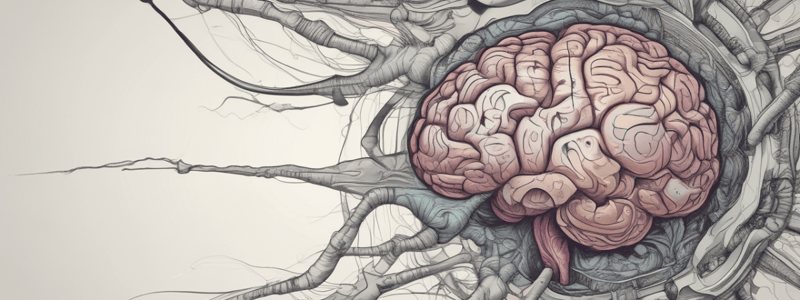Podcast
Questions and Answers
Match the following brain regions with their associated functions:
Match the following brain regions with their associated functions:
Ventromedial cortex = Emotional behaviors Anterior cingulate cortex = Salience network Dorsolateral prefrontal cortex = Temporal memory for motor information Orbitofrontal cortex = Learning by association
Match the following brain regions with their functions:
Match the following brain regions with their functions:
Frontal eye fields = processing corollary discharge information Supplementary motor cortex = programming rapid sequences of skilled movements Broca's area = selecting words based on internal and external stimuli Primary motor cortex = fine movements, speed, and strength
Match the following cognitive processes with their relationships to executive function:
Match the following cognitive processes with their relationships to executive function:
Goal-directed problem solving = supported by executive function Convergent thinking = involved in tests of executive function Emotional management = important for executive function Default mode network = not directly related to executive function
Match the following brain regions with their related networks:
Match the following brain regions with their related networks:
Match the following brain regions with their roles in language processing:
Match the following brain regions with their roles in language processing:
Match the following cognitive functions with their related brain regions:
Match the following cognitive functions with their related brain regions:
Match the following motor functions with their neural correlates:
Match the following motor functions with their neural correlates:
Match the following brain regions with their related cognitive processes:
Match the following brain regions with their related cognitive processes:
Match the following neural systems with their associated functions:
Match the following neural systems with their associated functions:
Match the following cognitive deficits with their neural correlates:
Match the following cognitive deficits with their neural correlates:
Match the following regions of the prefrontal cortex with their functions:
Match the following regions of the prefrontal cortex with their functions:
Match the following brain regions with their anatomical locations:
Match the following brain regions with their anatomical locations:
Match the following functions with their corresponding brain regions:
Match the following functions with their corresponding brain regions:
Match the following terms with their definitions:
Match the following terms with their definitions:
Match the following brain regions with their connections:
Match the following brain regions with their connections:
Match the following brain regions with their functional specializations:
Match the following brain regions with their functional specializations:
Match the following brain regions with their anatomical locations:
Match the following brain regions with their anatomical locations:
Match the following emotional processing components with their corresponding brain regions:
Match the following emotional processing components with their corresponding brain regions:
Match the following cognitive functions with their corresponding brain networks:
Match the following cognitive functions with their corresponding brain networks:
Match the following brain regions with their functional roles in motor regulation:
Match the following brain regions with their functional roles in motor regulation:
Match the following brain regions with their corresponding functional zones:
Match the following brain regions with their corresponding functional zones:
Match the following brain regions with their corresponding connections:
Match the following brain regions with their corresponding connections:
Match the following brain regions with their primary connections:
Match the following brain regions with their primary connections:
Match the following brain regions with their primary functions related to emotional processing:
Match the following brain regions with their primary functions related to emotional processing:
Match the following brain regions with their roles in emotional processing:
Match the following brain regions with their roles in emotional processing:
Match the following brain regions with their roles in motor function regulation:
Match the following brain regions with their roles in motor function regulation:
Match the following brain regions with their primary motor functions:
Match the following brain regions with their primary motor functions:
Match the following brain regions with their primary roles in the default mode network:
Match the following brain regions with their primary roles in the default mode network:
Match the following brain regions with their roles in the default mode network:
Match the following brain regions with their roles in the default mode network:
Match the following brain regions with their primary functions related to regulation:
Match the following brain regions with their primary functions related to regulation:
Match the following prefrontal cortex functions with their implications for behavior:
Match the following prefrontal cortex functions with their implications for behavior:
Match the following brain regions with their roles in emotional processing:
Match the following brain regions with their roles in emotional processing:
Match the following prefrontal cortex functions with their underlying neural mechanisms:
Match the following prefrontal cortex functions with their underlying neural mechanisms:
Match the following cognitive deficits with their neural correlates in the prefrontal cortex:
Match the following cognitive deficits with their neural correlates in the prefrontal cortex:
Match the following prefrontal cortex regions with their functions in motor function regulation:
Match the following prefrontal cortex regions with their functions in motor function regulation:
Match the following brain regions with their roles in the default mode network:
Match the following brain regions with their roles in the default mode network:
Match the following cognitive processes with their relationships to the prefrontal cortex:
Match the following cognitive processes with their relationships to the prefrontal cortex:
Match the following prefrontal cortex regions with their functions in emotional processing:
Match the following prefrontal cortex regions with their functions in emotional processing:
Match the following brain regions with their roles in motor response regulation:
Match the following brain regions with their roles in motor response regulation:
Match the following cognitive processes with their neural correlates in the prefrontal cortex:
Match the following cognitive processes with their neural correlates in the prefrontal cortex:




